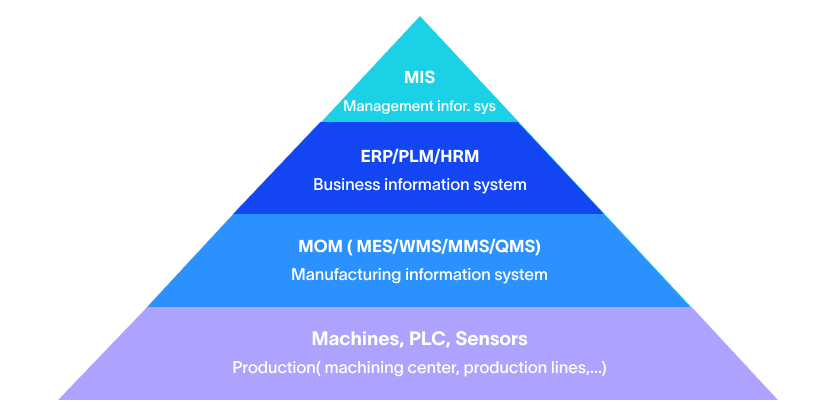Deloitte Manufacturing Industry Outlook 2025: Aligning with Results INS3 is Achieving with Manufacturers
Blog
7 Min 37 Sec Read
Executive Summary
According to Deloitte’s Manufacturing Outlook for 2025, there are many unique trends where INS3 can contribute. Smart data collection, AI tools, and MES functionalities of INS3 can match these trends and upgrade the Manufacturing Outlook.
In this article, we will analyse how INS3’s service offerings resonate with the major industry trends. However, our primary focus would be on analyzing how INS3 emphasizes the KPIs of operators.
Manufacturing Industry Context
The manufacturing outlook presents a plethora of opportunities, accompanied by some limitations that require prompt resolution. Meanwhile, most challenges are related to the industry’s economic environment.
Economic Environment
The manufacturing PMI entered contraction by July 2024, following a brief expansion, with falling orders and rising customer inventories signaling potential production cuts.
In this sector, stabilized at approximately 13 million workers, while material costs and total compensation continued to rise. Construction spending in manufacturing reached a record $238 billion in June 2024.
Learn how MES solutions that can revolutionize your factory floor
Critical Manufacturing Challenges
- Almost 60% of the manufacturing companies are unable to hold on to their prime talents. They are relentlessly facing the problem of employee turnover.
- Another 70% observed that poor data sets, weak contextualization, and lack of proper validation prevent AI implementation.
- It is hard to streamline manufacturing costs due to supply chain disruptions.
- Upscaling productivity is difficult, owing to higher material and labor expenses.
Discover how the right MES implementation can streamline production, boost efficiency, and improve decision-making.
Strategic Technology Implementation
INS3’s unique approaches and applications can take technology implementation to a different level. Here are some of the features it encompasses:
Intelligent Data Collection & Foundation for AI-Based Improvements
Three-quarters of manufacturers following Industry 4.0 norms have increased investment in data life cycle management to support AI strategy. However, data quality issues remain the most significant barrier to implementing AI in Manufacturing.
INS3 Data Architecture Results:
The streamlined connectivity protocols of INS3 can resolve the challenges regarding datasets. The unified data models also play a key role, enabling:
- Automated data collection to overcome the trial-and-error due to manual entries.
- The integrated systems can scan the production assets in real time.
- Swift and nuanced root cause analysis with the help of the contextualized data models
- Assorted data structures to organize enterprise reporting
Manufacturing Execution Systems Integration
Manufacturers are more interested in core digital investments to leverage the use of tech applications to drive high ROI. The investment in smart operations remains one of the primary aims in 2025.
Amplify your Ignition investment. Explore how MES integration delivers superior manufacturing intelligence.
Implementing INS3 MES Solutions:
- Over-Automation: Don’t let AI make critical decisions without human validation
- Data Quality Neglect: Clean your data foundation before adding AI
- Unrealistic Expectations: AI enhances expertise; it doesn’t replace manufacturing knowledge
- Change Management Failures: Ensure proper training for both traditional systems and AI toolsLorem ipsum dolor sit amet, consectetur adipiscing elit. Ut elit tellus, luctus nec ullamcorper mattis, pulvinar dapibus leo.
Operator and Shift Performance Management
The use of upgraded workforce management apps is supposed to go past 80% among major companies that employ employees on an hourly basis. Such brands will now focus on improving experience and operating efficiency.
INS3 Performance Management Results:
The foremost performance metrics used in managing operator performance are cycle time, quality rates, etc. INS3 also measures shift-level KPIs. The critical analytical tools used for the same are throughput analysis, tracking downtimes, and optimizing resource utilization.
INS3 has also introduced cross-shift benchmarking. It accounts for performance comparisons to identify the best practices and scopes for improvement.
The other two performance management mechanisms are the standardization of work instructions and the implementation of a new KMS.
The former ensures smooth implementation of execution protocols across all individual operators and shifts. The other helps in the systematic capture and retention of the operational expertise of clients.
Don’t let outdated systems hold you back. Learn how a unified MES and SCADA strategy can optimize your operations and boost your bottom line.
AI-Driven Manufacturing Optimization
Over 55% of manufacturers at an industrial level use generative AI. Another 40% are planning to invest in the implementation of increased AI and ML soon.
INS3 AI Application Results:
The application of INS3’s advanced framework can change the Manufacturing Outlook by matching the target indexes they are planning to incorporate in the future. INS3 ropes in predictive maintenance models where ML algorithms can identify equipment failures promptly.
The platform is also known for real-time detection of anomalies. The use of AI systems, especially, speeds up the process.
The other unique INS3 application is the optimization of production planning. Their advanced algorithms can improve the schedules effectively. Finally, the most critical application result of INS3 is conveying real-time recommendations to optimize the decision-making processes.
Gain ultimate control with instant insights. Explore how powerful MES connectivity puts real-time manufacturing data at your fingertips.
INS3 Implementation Methodology
The two critical elements of the implementation methodology are its Discovery Process and Implementing Approaches.
Discovery Process
For a better discovery process, the elements that INS3 endorses are assessment of current states, a detailed opportunity analysis, and development of a decent roadmap.
Processes | Analysis |
Assessment of Current State |
|
Opportunity Analysis |
|
Development of Roadmaps |
|
Implementation Approach
The implementation approach is primarily the three stages of INS3’s services coming together. These are:
Phases | Individual Features |
Foundation Phase |
|
Expansion Phase |
|
Optimization Phase |
|
Performance Management Framework
INS3’s unique Manufacturing Outlook can consolidate your performance management framework. Here are the added features that INS3 brings to the table:
Operator-Level Metrics
- Individual productivity and efficiency tracking
- Quality performance and defect rate monitoring
- Equipment utilization and setup time optimization
- Safety performance and incident reporting
- Training completion and certification management
Shift-Level Analytics
- Overall shift productivity and throughput measurement
- Downtime analysis with root cause identification
- Material consumption and waste rate tracking
- Energy usage and efficiency monitoring
- Team performance and collaboration assessment
Management Capabilities
- Real-Time Dashboards – Live performance visibility across operations
- Trend Analysis – Historical performance pattern identification
- Performance Benchmarking – Cross-functional comparison analytics
- Exception Management – Automated deviation alerts and notifications
- Continuous Improvement – Data-driven optimization opportunity identification
Operational Benefits and Improvements
The next-gen advancements in operations offered by INS3 are the following:
Production Excellence
- Component traceability systems reduce warranty and recall exposure
- Mixed-model scheduling capabilities improve manufacturing agility
- Automated tool management, optimizing setup, and changeover efficiency
- Assembly line balancing algorithms eliminate bottlenecks and improve flow
Quality and Compliance Enhancement
- Electronic batch record systems ensure regulatory compliance and audit readiness.
- Recipe and formula management, maintaining product consistency, and specifications
- Continuous process optimization algorithms maximize yield and minimize waste.
- Real-time quality monitoring reduces defect rates and customer complaints
Operational Efficiency Gains
- Integrated scheduling optimization across all production operations
- Unified quality management systems maintain standards across processes
- End-to-end traceability improves supply chain resilience
- Synchronized planning systems optimizing facility-wide resource utilization
Strategic Alignment
INS3 offers unique strategic assistance as well. The unique strategic elements onboarded by INS3 to improve your strategy at an organizational level are:
Technology Investment Priorities
Manufacturing technology investments increased from 23% to 30% of operating budgets in 2024, with cloud, generative AI, and 5G delivering highest ROI.
INS3 aligns with investment priorities through:
- Cloud-Based Architecture – Scalable, secure infrastructure, reducing deployment costs
- AI Integration – Practical applications delivering measurable business outcomes
- Advanced Connectivity – Real-time operational networking capabilities
Workforce Development
By 2030, AI-based employee skills management and deployment optimization will become core capabilities.
Ready to transform data into dollars? Learn how to leverage your MES system to fuel advanced AI and analytics, optimizing every aspect of your production.
INS3 operator and shift KPI systems provide foundational capabilities:
- Individual operator performance and capability tracking
- Skills gap identification and training optimization
- Data-driven workforce deployment strategies
- Performance-based scheduling and resource allocation
Conclusion
The current manufacturing outlook necessitates targeted investments in digital manufacturing foundations, advanced technologies, and high-ROI applications to achieve market leadership.
Technology investments accounted for 30% of operating budgets in 2024, with cloud, generative AI, and connectivity solutions delivering the highest returns.

Agile MES: The Key to Unlocking Smart Manufacturing Success
MES is a computerized system used in manufacturing operations to track and document the transformation of raw materials into finished goods. An MES system typically manages and monitors work orders, equipment, materials, and personnel on the shop floor. The system provides real-time visibility into production processes, helps optimize manufacturing operations, and improves the overall efficiency of the manufacturing process.

Understanding OEE: The Key to Manufacturing Efficiency
In today’s competitive manufacturing landscape, improving efficiency and productivity is crucial for businesses to remain competitive. One of the key metrics used to measure manufacturing efficiency is OEE or Overall Equipment Effectiveness. In this blog, we will take a closer look at OEE and its importance in manufacturing.

How to Effectively Conduct a Legacy System Integration
Legacy system integration can be a daunting task, but it’s a necessary one for many manufacturers that rely on outdated systems to run their business. Integrating legacy systems with modern technology can improve efficiency, streamline processes, and save time and money. However, it’s important to approach the integration process carefully and methodically to ensure success.
Share on :
Keep On Reading
Subscribe to Our Newsletter
Subscribe to our weekly newsletters to get updates regarding our new production, behind the scene process of our art creation and much more.
After submitting this form you will receive an e-mail with a confirmation link that you must click to complete your request. Detailed information on processing and cancellation can be found in our privacy policy.

